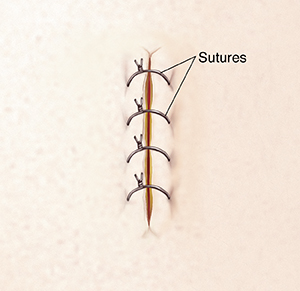A
B
C
D
E
F
G
H
I
J
K
L
M
N
O
P
Q
R
S
T
U
V
W
X
Y
Z
Click a letter to see a list of conditions beginning with that letter.
Click 'Topic Index' to return to the index for the current topic.
Click 'Library Index' to return to the listing of all topics.
Suture Care
Sutures or stitches are used to close wounds. They also help stop bleeding and speed healing. To help the wound heal, follow the tips on this handout.

Types of sutures
Some sutures need to be removed by a healthcare provider. These are called nonabsorbable sutures. Never try to remove them on your own. Others dissolve on their own and will not need to be removed These are called absorbable sutures. Sometimes strips of tape, staples, or skin glue (adhesives) are used. You’ll be told what kind of sutures you have.
The type of sutures you have are called: ______________________________________
Keep sutures clean
-
Don't do things that could cause dirt or sweat to get on your sutures. If needed, cover the sutures with a bandage to protect them.
-
Don’t pick at scabs. They help protect the wound.
-
Don’t wash the area around your sutures unless your healthcare provider says it’s OK. Then, follow their instructions for washing and drying.
Keep sutures dry
-
Keep the sutures out of water.
-
Take a sponge bath to prevent getting the sutures and wound wet, unless your healthcare provider tells you otherwise.
-
Ask your provider when you can take a shower or bathe.
-
Ask your provider about the best way to keep your sutures dry when bathing or showering.
-
If sutures get damp, pat them dry.
Changing the dressing
Leave the dressing in place until you are told to remove it or change it. Change it only as directed, using clean hands:
-
After the first ___hours, change the dressing every ___hours.
-
Change the dressing if it gets wet or dirty. Apply antibiotic ointment again if directed by your provider.
Other tips
-
Use the affected limb as little as possible to help wounds on an arm or leg heal. . Moving the arm or leg can cause the sutures to break apart. Sutures near a joint can break apart more easily.
-
Raise the area with sutures above your heart to help reduce swelling and throbbing..
-
Cover sutures with gauze to help prevent itching. Try not to scratch them if they itch.
-
Try acetaminophen or ibuprofen for pain relief if advised by your provider. Don’t use aspirin. It can increase bleeding.
-
For skin glue or skin tape: Don't pick or scratch the area. The tape or glue will fall out on its own in several days.
-
For absorbable sutures: These sutures dissolve on their own. Your provider can tell you how long this will take. You don't need to return to have your sutures removed.
-
For removable sutures or staples: You will need to be seen to have your sutures removed. Call your provider or return to have your sutures removed in ________days.
-
Keep the stitches out of direct sunlight. This lowers the chance of burning and scarring. After sutures are dissolved and or removed and the wound has healed, place sunscreen on the area when in direct sunlight for the next several months. Use a broad-spectrum sunscreen with SPF 30 or higher.
When to call your healthcare provider
Call your healthcare provider if you notice any of the following signs:
-
Increased soreness, pain, or tenderness after 24 hours
-
A red streak, increased redness, or puffiness near the wound
-
White, yellowish, or bad smelling discharge from the wound
-
Bleeding that can’t be stopped by applying pressure
-
Adhesive strips fall off, stitches dissolve before the wound heals, or wound breaks open
-
Fever of 100.4°F (38.0°C) or higher, or as directed by your provider
Online Medical Reviewer:
Eric Perez MD
Online Medical Reviewer:
Marianne Fraser MSN RN
Online Medical Reviewer:
Sara Mauldin FNP
Date Last Reviewed:
4/1/2024
© 2000-2025 The StayWell Company, LLC. All rights reserved. This information is not intended as a substitute for professional medical care. Always follow your healthcare professional's instructions.